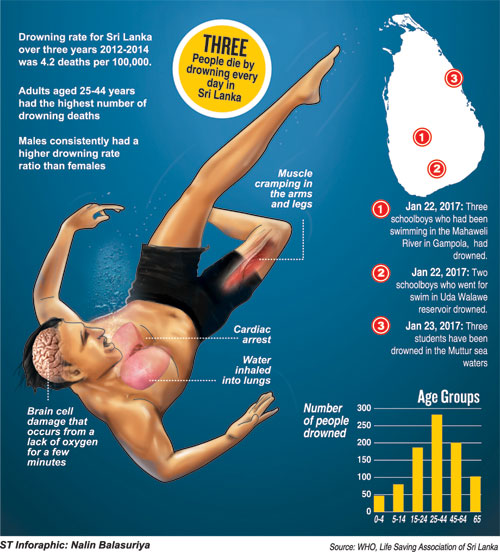News
Teach methods to help prevent drowning tragedies, life-savers urge
View(s): Raise further awareness in the country about life-saving techniques and first aid to help prevent continuing deaths from drowning, experts plead.
Raise further awareness in the country about life-saving techniques and first aid to help prevent continuing deaths from drowning, experts plead.
Tragedies are continuing and many who die from drowning are young.
Two youths who jumped into the Mahaweli river in Gampola hoping to help their friends from drowning were among eight young people including a 13-year-old who drowned in three separate incidents in Gampola, Uda Walawe and Mutur.
Youths Darshan and Bhagya tried to help their friends from drowning two kilometres away from Ethgala, Gampola, where about 15 had died in similar circumstances.
“When Gayan, Sandeepa, and Themiya shouted for help, without any hesitation Bhagya and I jumped into the river. But the river was turbulent,’’ Dharshan told the Sunday Times. He said there was no one else to help. The bodies were recovered by the navy.
Two more young people, both 19 years old, drowned in Udawalawe last Sunday. They were among a group of five which had come to take a dip in the Udawalawe reservoir last Sunday, near the Udawalawe Elephant Transit Home. Their bodies were also recovered by the navy with the help of police and fishermen.
On Monday evening, three youths aged between 17 and 20 years, drowned in Mutur. They had been enjoying a dip in the ocean off Harib Nagar beach, Mutur.
According to the Drowning Prevention Report 2014, the first and the only detailed report about drowning in Sri Lanka, compiled by the Life Saving Association of Sri Lanka, on average 850 people drown each year, one of the highest drowning rates in the world.
The Western Province had the highest number of drownings with 236 deaths that year.
“Alcohol consumption around bathing areas, lack of life guards, unregulated tourism, poor swimming ability and water safety knowledge mainly contribute to drowning in the island,” explained, Asanka Nanayakkara, the Secretary General of the Life Saving Association of Sri Lanka.
The life-saving group says lakes are the top drowning location in Sri Lanka followed by oceans and beaches.
Males are four times more likely to drown than females with a drowning rate of 7.2 deaths per 100,000 population compared with 1.6 deaths per 100,000 for females, the report by the life-saving group reveals.
“There are about 51 Life Saving Service Locations in Sri Lanka with a total of 1,319 qualified life guards performing duties under 39 life saving clubs. Over 400 rescues are reported annually,’’ said Nanayakkara, who is also an international life saver.
Tony Fernando, president of Kinross Swimming and Life Saving Club, said children should be encouraged to learn to swim. Deploying life savers to each and every bathing spot is not practical, he added.
Senior Superintendent of Police H. H. Chulasiri who is an international instructor and life saver, commenting on the recent incidents, said teenagers are vulnerable because of alcohol consumption and normal risk taking behaviour.
“Most of the drownings have occurred when the victim had no idea about the location. Bathing near a sluice and in places where the water is unclear is dangerous,” he said.
Going for a swim immediately after a heavy meal, after drinking alcohol, wearing unsuitable clothes for swimming, overestimating your swimming abilities, and inability to understand rip currents can lead to drowning, he emphasised.
Those who don’t know life saving skills can throw a rope or bamboo stick, a floating device, or use a boat to save someone from drowning.
“To save a drowning person the best thing is to follow globally accepted life saving techniques. Therefore community awareness should be increased about life saving and first aid,” he said.
He advised people to enjoy aquatic activities within the red and yellow flagged sites where life savers are on duty.

